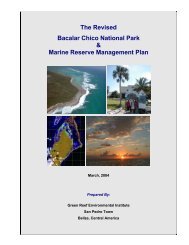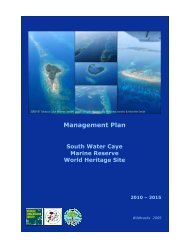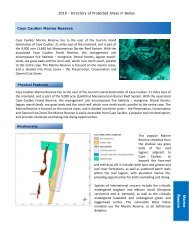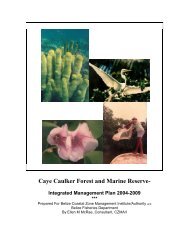Management Plan - Glover's Reef Marine Reserve
Management Plan - Glover's Reef Marine Reserve
Management Plan - Glover's Reef Marine Reserve
You also want an ePaper? Increase the reach of your titles
YUMPU automatically turns print PDFs into web optimized ePapers that Google loves.
Patch <strong>Reef</strong>s<br />
Glovers <strong>Reef</strong> <strong>Marine</strong> <strong>Reserve</strong> – <strong>Management</strong> <strong>Plan</strong><br />
The majority of the more than 850 patch reefs within the Atoll’s lagoon are distributed randomly<br />
with the exception of those in the western and northeast portions of the Atoll where they are<br />
aligned along NNE-striking trends. They range in size from about 10 m to a few hundred<br />
meters (Wallace 1975). They consist of massive corals such as Montastrea, Diploria,<br />
Siderastrea and Porites, with occasional thickets of Agaricia and Acropora cervicornis; sea fans<br />
and brown algae are abundant on dead coral surfaces (McClanahan & Muthiga 1998).<br />
In the 1970s, three distinct coral assemblages were recognized along a north-south transect<br />
namely: Montastrea, Acropora and Algae-Porites. This distribution mimicked the zonation on<br />
the seaward reef tracts, and was believed to be a response to disturbances such as hurricanes<br />
(Wallace & Schafersmann 1977). A list of coral species of the patch reefs provided by Wallace<br />
(1975) is shown in Appendix 4.<br />
More recent studies have also focused on the composition of the Atoll’s patch reefs, and show<br />
that they have undergone a major change in their ecology. They have experienced a 75%<br />
reduction in coral cover (with M. annularis showing the least loss), a 99% loss in cover of<br />
Acropora spp., and a 315% increase in algae cover, particularly of the erect brown algae<br />
Lobophora (McClanahan & Muthiga 1998). The cause for this dramatic change over the past<br />
25 years is complex, and probably due to several inter-related factors, such as reduced<br />
herbivory, increased level of nutrients, and disease.<br />
The patch reefs no longer exhibit the zonation described earlier by Wallace and Schafersmann<br />
(1977). Furthermore, the phase change in community structure has resulted in the 80% hard<br />
coral cover and 20% algae cover reported by Wallace (1975) to be transformed to a 20% coral<br />
cover and 80% algae cover (McClanahan & Muthiga 1978).<br />
Lagoon Floor<br />
The lagoon floor, which ranges in depth from 6 to 18 m, is comprised of predominantly fine<br />
sand and mud sized carbonate sediment. It supports a sparse flora of Thalassia and algae,<br />
mainly Penicillus with some Halimeda (Wallace 1975).<br />
Some deeper areas of the lagoon are almost completely barren of vegetation, though<br />
echinoderms and other invertebrates are common.<br />
Wildtracks / Wildlife Conservation Society, 2007 32






